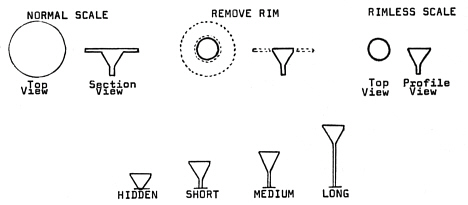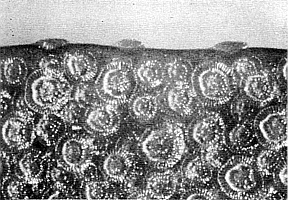QBARS - v17n4 Rimless Scales on Lepidote-Non-Lepidote Hybrids
Rimless Scales on Lepidote-Non-lepidote Hybrids
Alexander C. Martin, Los Gatos, California
Because just one lepidote-elepidote hybrid, 'Grierdal', has been recognized in about 150 years of rhododendron breeding, my report on 24 such crosses, plus 3 lepidote-azalea combinations, will need more than mere assertion and faith. That's why the focus will be primarily on tiny leaf outgrowth of the kind that helped validate the unprecedented parentage of 'Grierdal', nearly a quarter-century ago. 1
The term non-lepidote will be used here to embrace elepidote rhododendrons and azaleas; generally the designation elepidote excludes azaleas.
I am indebted to George M. Cunningham for skillful, generous cooperation in the photography. Also, the Maurice H. Sumners, the Edward H. Longs, Charlotte Kenna, and other friends helped by allowing me to hybridize on their plants or by making pollen available.
The Diagnostic Structures
What to call the curious little objects on lepidote-non-lepidote leaves is somewhat of a problem; they look like compromises between scales and hairs, and probably are just that, as suggested by Dr. Cowan. 2 In describing this sort of pseudo-scale on 'Grierdal', he stated: "Instead of appearing on surface view as a flat plate or shield, the scale appears as a compactly rounded head." That's exactly the way they look on my hybrids: tiny, roundish globules, with no marginal rim or brim (Fig. 47). And that's why the name rimless scale is used here.
An additional distinction that was noted between normal scales of lepidotes and the rimless type of scale on 'Grierdal' was the elongated stalk of the latter. In Miss Waterston's words: "...an abnormally large stalk." Many of my hybrids also have long stalked rimless scales, and many do not; it's an inconsistent feature, varying from cross to cross or plant to plant.
On some of the hybrids, the stalks of rimless scales are so short that instead of extending out of the shallow depressions in which they occur, they are hidden under the scale head, as Dr. Cowan has indicated is typical for normal scales. 3 However, visible stalks are present on many of the scales of hybrids. When seen in profile, as along leaf margins, rimless scales resemble fairy goblets of a solidified sort, some without evident supports and others with short, medium, or tall stems (Fig. 44).

|
|
Fig. 44. Above: Diagram contrasting normal scales with
rimless ones. Below: Variation of stalks of rimless scales. |
Hand-lens examination of all the hybrid seedlings (about 125), accompanied by sketches and notes for each lot, disclosed surprisingly consistent similarity in the rimless scales throughout, regardless of whether the seed parent was lepidote or non-lepidote. This uniformity was particularly evident in: (1) the absence of a rim on all the scale-like structures-without a single exception; (2) consequent substantial reduction in scale-head size: (3) the solid-goblet profile outline. The scale-head diameter seemed about equivalent in all instances, though it may be slightly greater in examples with hidden stalks.
Because of this uniformity, macro-photographs of rimless scales on all 27 of the hybrid lots would have been monotonously repetitious and doubtfully justified. Consequently, representative examples are shown instead in Fig. 47.

|

|
| Fig. 46. Normal scales of R. carolinianum |
Fig. 47. Rimless scales of
R.
carolinianum x 'Goldbug'. |
Besides variation in stalk length, already discussed, there is considerable diversity in abundance or scarcity of the tiny, rimless structures themselves. When the leaf has a coat of hairs and the scales are few and far between, they are sometimes difficult to locate. A lush specimen of 'King of Shrubs' x 'Forsterianum', additional to the one shown in Fig. 48, was temporarily "written off" as apomyctic until closer scrutiny disclosed a few rimless scales among somewhat similar glandular hairs. On the somewhat hairy leaves of 'Vulcan' x R. bullatum seedlings, the structures are also sparse and not easily found. The smallest of the three R. carolinianum x 'Elizabeth' seedlings is a strange maverick that shows no scales at all.
A Summary of Lepidote-non-lepidote Clues
Study of the hybrids has yielded the following clues that seem to point to lepidote-non-lepidote ancestry:
- Presence of rimless, globular or goblet-shaped, scale-like structures;
- That are considerably smaller than normal scales;
- And are distributed more sparsely over the leaf surface;
- And often have stalks long enough to be visible, whereas the short stalks of normal scales are always hidden;
- Rimless scales on plants from non-lepidote seed parents would seem to be especially conclusive evidence;
- It also appears significant when, as in my numerous seedlings from crosses onto R. carolinianum , lots from different pollen parents display obvious dissimilarities in the shape, size, color, texture, and pubescence of leaves, as well as in the color of petioles and stems.
The Crosses
In 1959 lepidote-non-lepidote hybridizing was added to my exploratory projects, when four such crosses were tried but all failed. In the three following seasons, positive results were obtained from total attempts as follows: 1960: 3 out of 18; 1961: 9 out of 91; 1962: 15 out of 82.
